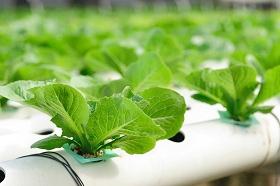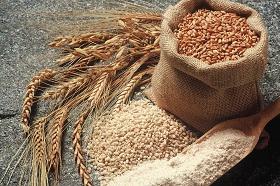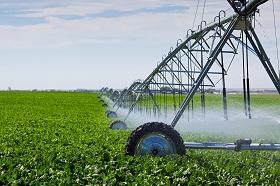Using AI to control energy for indoor agriculture
30 September 2024
Published online 25 April 2010

The countries of the Gulf Cooperation Council (GCC) with a total population of ~40 million, of whom 40% are foreign workers, are endowed with oil and gas reserves estimated at some USD 35 trillion This puts the region's nationals among the world's richest peoples in terms of per capita wealth. However, although the region's economic and energy security are assured, the GCC countries are the world's most water insecure and food deficient, importing 60–90% of their food requirements.
Vulnerability of GCC food supply
The world food crisis in 2007–2008 saw staple food prices rising more than twofold in a matter of weeks, triggering food riots around the world. A number of major producers reacted to this evolving situation by imposing embargoes on staple food exports such as the ban on rice exports by India, which traditionally supplies over one-half of the rice consumed in the GCC countries.
These concerning events have put the GCC countries on notice that their food security is vulnerable to disruptions and supply–demand imbalances in world food markets. Urgent measures are needed to ensure future food supplies. This could be achieved through two options. The first is to enhance domestic production. The second is to secure import food supplies through international agricultural investments in countries that have untapped land-water resources, especially those that are geographically and culturally close to the GCC countries, such as Sudan, Pakistan and Turkey.
Enhancing domestic production
The limited land and water resources in the GCC countries pose a substantial technological challenge to increasing domestic food production. Of the region's total land area of ~259 million ha, only 1.7% is currently under cultivation, mainly with groundwater irrigation. Although about one-fifth of the total land area is potentially cultivable, the region's arid climate and constraints caused by severe biotic and abiotic stresses, including heat, salinity and lack of improved cultivars, limit the levels of food sufficiency that can be achieved.
Some of the GCC countries have established fossil fuel-driven water-desalinization plants, contributing ~15% of the total available water resources in the region. However, current concerns about climate change, and the fact that the GCC has one of the highest carbon footprints in per capita terms, limit this option. Investment in research into the use of renewable energy, particularly solar power, in future desalination plants offers a means to increase domestic food production.
There is growing interest around the world in greenhouse hydroponics as, compared with traditional agriculture, they use substantially less water and land resources. They also have a reduced environmental impact as nutrients are not leached into the soil or water.
The GCC should give the highest priority to establishing a regional centre of excellence for solar-energy research for water desalination, greenhouse solar cooling and greenhouse hydroponic-technology development. This is of relevance to the GCC's sustainable development agenda for reducing its carbon footprint and increasing the efficient use of land and water resources.
Relevant research

The International Center for Agricultural Research in Dry Areas (ICARDA) has done extensive research on agriculture in the Middle East. The International Center for Biosaline Agriculture (ICBA) focuses on the use of saline and marginal quality water for agriculture. The two centres offer a wealth of germplasms in their gene-bank collections for molecular-biology research and the development of food crop varieties that can withstand high temperatures, droughts and salinity.
Furthermore, a dedicated GCC agricultural research centre for dry-land crops, livestock and aquaculture development, and adaptation to future climate change should also be established. Such an initiative would contribute worldwide to sustainable development in semi-arid and arid areas, which account globally for ~40% of the Earth's land surface and are home to over one-third of the world's population.
Regionally relevant research into protected agriculture, solar energy for desalinization and greenhouse hydroponics has the potential to enhance domestic food self-sufficiency in the GCC countries. However, some crops, such as wheat, require as much as 1,400 kg of water to produce 1 kg of yield. This calls for strategic decisions about which crops to produce locally and which to secure through international GCC investments.
Assuring imports: at whose cost?
Over the past few years, the GCC countries have begun to consider investing in farmland overseas, particularly in sub-Saharan Africa (SSA). However, there is growing worldwide concern that such international agricultural investments must be environmentally, economically and socially responsible and sustainable. They must also be well-structured and legally executed. Otherwise, there is a risk that the burden of food insecurity in the investing GCC countries might end up being transferred to the SSA host countries.
In the nineteenth century, European colonialism expropriated land in Africa for cash crops, and the indigenous populations were forced to farm without remuneration. Today, in the twenty-first century, foreign land is acquired through agreements, often made with national governments. It is critical that such agreements involve all stakeholders and ethically take into account the local social, environmental and economic costs and benefits.
Science-based informed agreements

A key obstacle to more transparent debate and informed decisions by governments and investors is the lack of science-based information 1,2 , in particular on the agro-ecological3 suitability of any given locality for different types of crop.
At a national level, this information can be crucial. Parametric assumptions about yield and input levels, and application of a vector of output and input prices adjusted for transport cost spread over an appropriate time period, would allow the computation of expected investment returns and land rents from any given use.
This would allow host governments to assess their comparative advantages better in negotiations with outside investors. Globally, such information can help investors who are interested in certain types of crop to identify the most appropriate countries and macro-regions to consider.
Balancing the costs and benefits of assured imports
The International Institute for Applied Systems Analysis (IIASA), in collaboration with the Food and Agriculture Organization of the United Nations (FAO), has developed an integrated agro-ecological and socio-economic methodology, and a global database for assessment of policy options for food security and sustainable agricultural development4,5.
This IIASA methodology has been applied in collaboration with the World Bank to provide global, regional and national insight and decision support for investors and host-country governments to facilitate sustainable and responsible international agricultural land investments.
The high production potentials of technological sustainable agriculture in SSA, reported in the forthcoming IIASA–World Bank study6, show great promise.
Of the current rain-fed cultivated land area in SSA (225 million hectares), the food crop-suitable area (~197 million hectares) would generate a value of production estimated at 360 billion 2000 Geary-Khamis (international) dollars (GK$2000). Current yields are a factor of three to five lower and thus agricultural investments have the potential to generate high returns.
The unprotected grassland and woodland area in SSA that is suitable for food crops (~477 million hectares) would generate a value of production estimated at GK$2000 840 billion. The unprotected forest land area suitable for agriculture would generate a value of production estimated at GK$2000 654 billion.
These numbers show that there is considerable potential for profitable agricultural investments in current cultivated land areas as well as unprotected grasslands, woodlands and forests. Just 10 countries — namely, the Democratic Republic of Congo, Ethiopia, Sudan, Tanzania, Angola, Mozambique, Zambia, Benin, Liberia and Nigeria — account for >50% of the total SSA agricultural potentials.
The report shows greater yield rewards in the unprotected grassland, woodland and forest areas. However, land clearances in these areas pose a threat to biodiversity as well as the potential for soil carbon emissions. Agricultural development might end up creating enclaves of 'advanced farming' that is detached from the local realities of subsistence agriculture in the areas already cultivated.
Investment priority should be given to the current cultivated land areas, as this approach has good potential for a win–win partnership for the investor as well as the local community. Although contract farming has been demonstrated as a means to generate cash income for farmers in developing countries, this mainly works in areas with well-functioning markets. In many countries in SSA, agricultural markets and distribution channels are lacking. This inhibits the timely purchase of inputs for the farmers' local production, which in turn would result in food-supply shortfalls in the domestic market, thereby driving up food prices.
A proposed partnership model

A shared-benefits model that would best meet the needs of the investor and the local community7 in currently cultivated land areas where the yield gaps are large could provide the basis for responsible and sustainable agricultural development partnerships.
Consider a situation in which 100 units of land area farmed with poor management and low agricultural technology produces 100 tonnes of a food commodity. With foreign investment bringing in sophisticated technologies and management, the production on this piece of land is boosted to 500 tonnes. The local community receives 200 tonnes, while the investor receives a similar share. The remaining 100 tonnes is then sold by the investor into the local market.
The market sale would be important in terms of host-country food security, and the sales income would be reinvested for the benefit of the local community through infrastructure and social-services development. The investor's share would need to be acceptable in terms of return on investment.
Such an innovative partnership arrangement could be further structured as an official development aid (ODA). Another option is a state-sponsored lease of lands in a developing country to a private-sector investor that brings modern management and best practices for a profitable enterprise and an agricultural aid-development partnership with the local community. The funding partner would provide oversight and monitoring to ensure that the long-term investment responsibility and sustainability are assured.
SSA, with its fertile land, ample water resources and the world's lowest agricultural productivity, is the biggest hot spot for agricultural land acquisition by public and private investors from the GCC, China, India and Europe. The agricultural sector in SSA countries is in urgent need of investment capital.
However, decades of poor government commitments to agriculture and low investments have resulted in stagnating productivity and food-production levels. The SSA countries' capacity to fill the investment gap is limited and the pledges of ODA are often not delivered.
The risks attached to international agricultural investments, especially in developing countries that are themselves food insecure, are of concern. The initiative by multilateral institutions — namely, the FAO, the International Fund for Agricultural Development (IFAD), the United Nations Conference on Trade and Development (UNCTAD) and the World Bank — to develop principles for responsible agriculture investment that respects the rights, livelihoods and resources of local communities is a welcome and timely development. This is especially important in light of increasing media reports of land deals between investors and governments in host countries that have failed to ensure that fair benefits will accrue to the local populations.
Sudan's unique position

Sudan's vast land and water resources are perceived as ripe for agricultural development investment. Several GCC countries have signed land deals with the government of Sudan. However, sustainable implementation strategies that are of mutual benefit remain to be seen. Sudan has the potential to supply all the cereal, sugar, fodder and other essential foodstuff needs of the GCC, but it is important that investments also contribute to reducing the hunger affecting over one-fifth of the Sudanese population. In addition, the country urgently needs to resolve its regional conflict.
The GCC countries have a real opportunity to invest in Sudan as a development aid partner, not only to assure their own food security but also to contribute to sustainable agricultural development4,5. The potential through a shared partnership model, as described above, is substantial. For example, current maize yields of ~1.2 tonnes/ha can be increased to >7 tonnes/ha with high agricultural technology and management.
Responsible agricultural investments can contribute to sustainable agriculture development towards achieving food security and an end to the hunger that today affects one-third of the population in SSA.
The GCC's challenge is to adopt a scientific, knowledge-based and policy-relevant integrated agro-ecological and socio-economic approach to enhancing its domestic food production. This can be done only by forming sustainable and responsible development partnerships that can put the SSA countries on a path of progressive and sustainable development.
Mahendra Shah is the director of the Qatar National Food Security Programme.
doi:10.1038/nmiddleeast.2010.141
Stay connected: